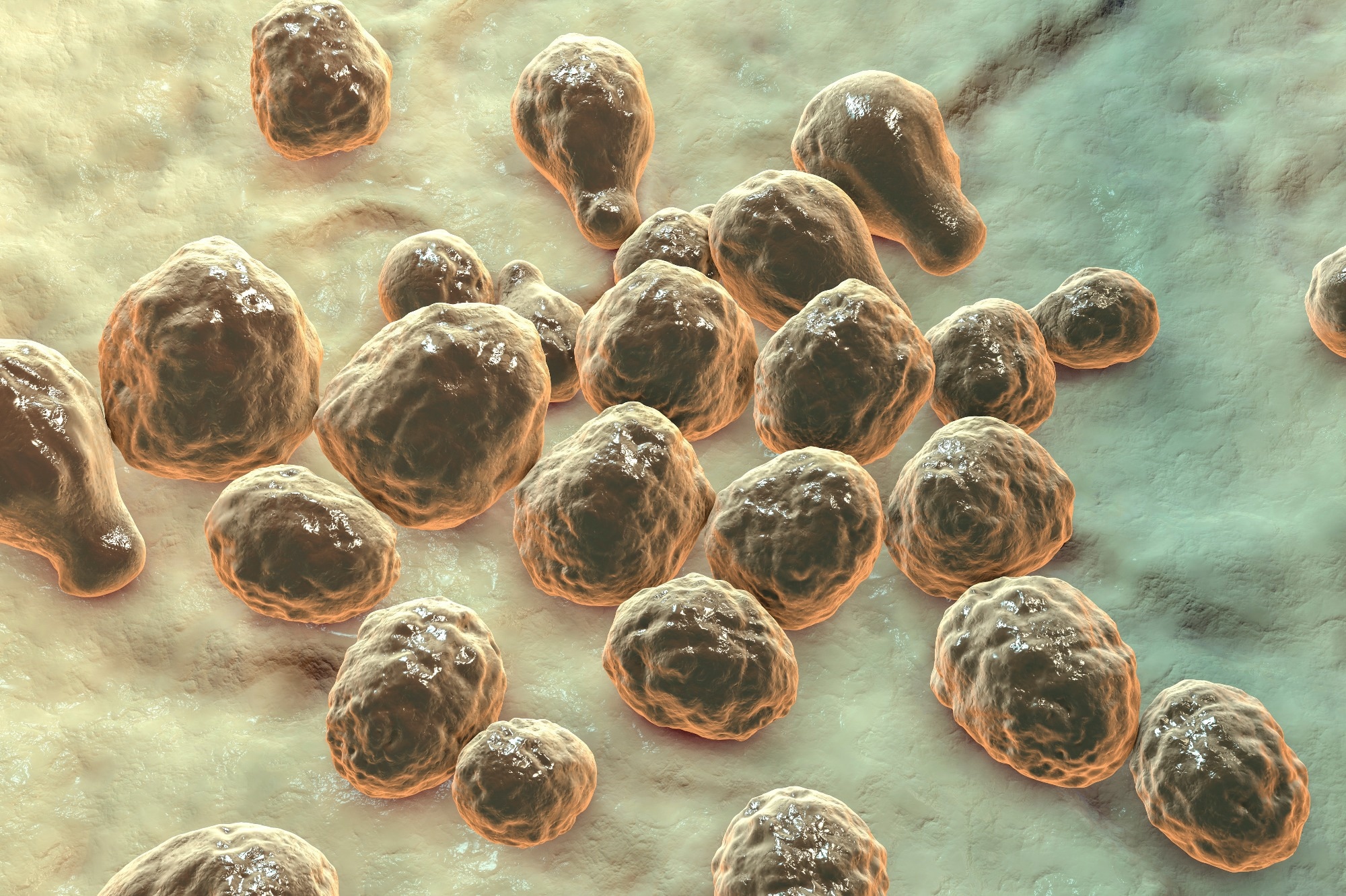In a recent study published in Nature Microbiology, researchers examined metabolite-drug-fungal interactions in the fungal meningitis pathogen Cryptococcus neoformans.
 Study: Brain glucose induces tolerance of Cryptococcus neoformans to amphotericin B during meningitis. Image Credit: Kateryna Kon/Shutterstock.com
Study: Brain glucose induces tolerance of Cryptococcus neoformans to amphotericin B during meningitis. Image Credit: Kateryna Kon/Shutterstock.com
Background
Antibiotic resistance refers to the capacity of a vulnerable population to withstand high doses of cidal medications, limiting therapeutic results in bacterial infections. The role host-derived factors play in fungal diseases like C. neoformans is uncertain.
Amphotericin B (AmB) is the only fungicidal treatment for fungal meningitis; however, genetic resistance is uncommon. Treatment results impact fungal tolerance to fluconazole in individuals infected with genetically sensitive Candida isolates.
About the study
In the present study, researchers explored in vivo AmB tolerance produced by host metabolites.
To assess the influence of host metabolites on the efficacy of AmB against C. neoformans, the researchers developed a metabolite-drug screening technique based on a BIOLOG phenotypic microarray.
They received human cerebrospinal fluid (CSF) samples from Shanghai Changzheng Hospital, the primary location of C. neoformans infection during meningitis. They used a high-performance anion-exchange chromatography (HPAEC) device to quantify glucose in the samples.
They tested AmB effectiveness on wild-type and mig1 strains in the presence of glucose. They devised a single-cell-based method to examine the relationship between nuclear localization and Mig1-mediated AmB tolerance.
The team examined the role of Mig1 in AmB tolerance after brain infection in mice to investigate whether brain glucose generates Mig1-mediated GR and probable AmB tolerance.
They examined dynamic gene expression in wild-type and mig1 fungi after AmB exposure under drug-tolerant (glucose) or drug-sensitive (galactose) conditions using time-series ribonucleic acid sequencing (RNA-seq). They examined the lipidomes of wild-type and mig1 cells in response to glucose availability.
The researchers examined the impact of terbinafine, an ergosterol synthesis inhibitor, on glucose-induced AmB tolerance. They isolated inositol phosphorylceramide (IPC) from Cryptococcus neoformans cells and investigated its influence on AmB tolerance.
They used surface plasmon resonance (SPR) spectroscopy to investigate whether inositolphosphorylceramide competes with amphotericin B for ergosterol, restricting AmB's ability to kill C. neoformans cells.
The researchers injected C57BL/6J mice intravenously with 105 wild-type Cryptococcus neoformans cells to evaluate the effectiveness of AbA and AmB coadministration versus AmB monotherapy. They administered AmB once daily at 3.0 mg/kg for one to two weeks.
They adopted a brain-targeting liposomal drug delivery strategy to improve AbA's access to the brain. They sacrificed the animals seven days after infection and examined brain tissues to assess the fungal load and count colony-forming units (c.f.u.).
They generated and tested a C. neoformans bioluminescent strain in vitro and in vivo and used polymerase chain reaction (PCR) to validate gene substitution.
Results
The researchers found a significant decrease in growth inhibition by 2-DG in mig1 cells, confirming the role of cryptococcal Mig1 in GR.
The findings indicated that glucose at concentrations comparable to those observed within the brain may significantly generate AmB tolerance, implying that glucose-induced AmB tolerance may exist in the human brain.
The researchers established galactose repression (GR) in Cryptococcus neoformans and found that 2-deoxyglucose (2-DG), a non-metabolizable-type glucose analog, successfully induced AmB tolerance.
The findings support the theory that GR activation, rather than glucose catabolism, leads to glucose-induced drug tolerance.
Through the fungal glucose repression activator Mig1, brain glucose enhanced C. neoformans resistance to AmB in murine brain tissue and patient CSF.
Mig1-regulated tolerance reduced therapy effectiveness for cryptococcus-induced meningitis in the murine animals by decreasing ergosterol synthesis, AmB's target, and increasing that of inositolphosphorylceramide, the competitor of amphotericin B for ergosterol.
Further, amphotericin B and aureobasidin A, the inhibitor of fungal-specific inositolphosphorylceramide synthase, outperformed clinically indicated therapy in mice against cryptococcus-induced meningitis.
Compared to carbon-based metabolites, glucose causes AmB tolerance in C. neoformans, with a higher survival percentage in conditions containing nitrogen-, phosphorus-, and sulfur-containing metabolites. Glucose is a critical carbon group metabolite that promotes cryptococcal resistance to amphotericin B, and its content correlates favorably with AmB tolerance stimulation.
Replacing galactose with glucose, fungal cell counts surviving after AmB therapy approached those of BIOLOG plates.
Glucose-induced amphotericin B tolerance did not depend on macronutrient consumption since carbon-based molecules like galactose could not successfully trigger drug tolerance.
GOX rapidly removed glucose from CSF, while manganese dioxide therapy reduced H2O2 levels. Gluconic acid had a negligible impact on amphotericin B tolerance. C. neoformans tolerance to AmB was reported in CSF samples from cryptococcal meningitis patients cultivated in human CSF.
The fungal regulator Mig1 plays a vital role in glucose-induced AmB tolerance. Glucose metabolism intermediates did not induce AmB tolerance, indicating that glucose tolerance depends on its regulatory role rather than catabolism.
In the cryptococcal meningitis murine model, Mig1-mediated AmB tolerance resulted in a reduced therapeutic effect. The study also showed that AmB and AbA had an additive impact on C. neoformans cells, indicating a possible therapy for cryptococcal meningitis.
Conclusions
The study findings showed that glucose increases fungal AmB resistance through the Mig1 glucose repression regulator during cryptococcal meningitis. In vivo, host-obtained metabolites could elicit fungicidal tolerance.
Mig1-mediated brain glucose tolerance dramatically reduced AmB treatment effectiveness in rats. The findings indicated that tolerance-specific genes in fungi may be viable targets for adjuvant therapy.
g1 disruption considerably altered membrane lipid components, showing that Mig1 may play a role in AmB tolerance and membrane integrity.